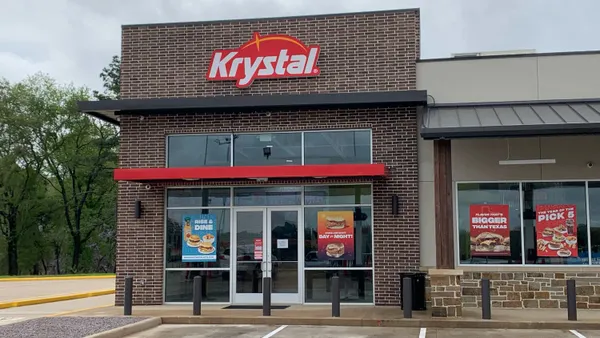Dive Brief:
- NPC International, Pizza Hut’s largest franchisee, announced an agreement Monday with Pizza Hut that would allow NPC to close up to 300 of its Pizza Hut restaurants. According to a press release, a substantial number of those locations are traditional Red Roof dine-in formats, which experienced closures amid the novel coronavirus pandemic.
- NPC filed for Chapter 11 protection in July with $903 million in debt.
- "This key agreement provides NPC with flexibility to explore options for achieving a value maximizing outcome as it seeks to finalize the terms of a comprehensive financial restructuring and emerge from Chapter 11," the release states. Pizza Hut plans to reallocate employee resources to “thriving locations" at NPC and other Yum Brands' locations where possible.
Dive Insight:
NPC is far from the only restaurant operator closing a significant number of locations as the true impact of the coronavirus, and months of closures and lower revenues, begin to be felt. Dunkin’, McDonald’s and Starbucks are closing a combined 1,400 locations, for example.
But NPC has been struggling since well before the pandemic. Reports of the company considering bankruptcy trace back to February. Huge amounts of debt and a vast dine-in footprint were challenges then, and were exacerbated during a crisis that created the need for cash-on-hand and strong off-premise business.
NPC operates 1,227 Pizza Hut restaurants, or about 16% of the chain’s U.S. system, so any financial challenges that arise from within this franchisee is likely to have material implications across the entire company. This agreement is likely a move to avoid any further negative impact. In a statement emailed to Restaurant Dive, a Pizza Hut spokesperson said, “We have continued to work with NPC and its lenders to optimize NPC’s Pizza Hut restaurant footprint and strengthen the portfolio for the future, and today’s joint agreement to close up to 300 NPC Pizza Hut restaurants is an important step toward a healthier business.”
The statement went on to acknowledge these specific locations significantly underperformed compared to the rest of NPC’s Pizza Hut network.
Pizza Hut has been exploring a shift away from its traditional Red Roof dine-in locations toward a delivery/carryout model for years, but the pace of this change has been slow. As competitors like Domino’s and Papa John’s generate most of their sales through delivery and carryout, however, time is of the essence.
The pandemic has driven significantly more consumers to digital channels regardless of cuisine type. Upserve’s customers report a nearly 783% increase in online order sales volume growth during the crisis as of July, for example. Pizza chains likely have an advantage here as early adopters. Domino's generated 75% of its sales through digital channels in Q2, its 37th consecutive quarter of same-store sales growth.
This digital shift is a primary reason why Pizza Hut has been losing market share to Domino’s and Papa John’s in recent years, and that gap could widen on the other side of this crisis if the company falls any further behind in digital and carryout business. Further, Pizza Hut's customers have made it clear that they want this same digital convenience. During the month of May, Pizza Hut U.S. turned in its highest average sales week for delivery and carryout in the past eight years.
Last year, David Gibbs, CEO of parent company Yum Brands, said Pizza Hut was going to accelerate its transition to “truly modern delivery and carry-out assets” to get the chain poised for faster long-term growth. If there is a silver lining to this bankruptcy and subsequent mass closure, it’s that it will enable the company to push the gas even harder, likely leaving NPC — and Pizza Hut — with a stronger performing system overall.













